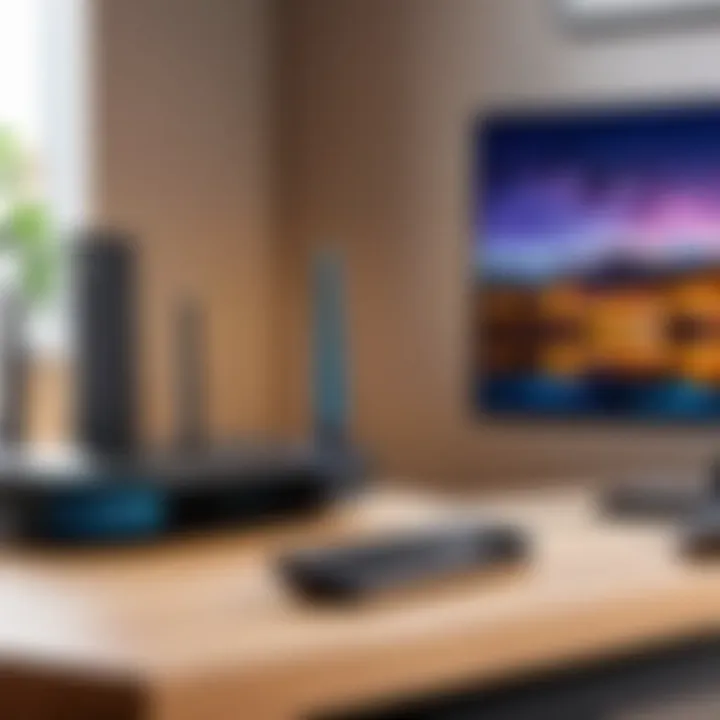Resolving Netgear Nighthawk Mesh Satellite Issues


Intro
Netgear Nighthawk mesh satellites serve as a crucial component in enhancing the connectivity and reach of a home or office network. When functioning correctly, they provide seamless internet coverage and improved performance. However, users often encounter issues where these satellites fail to establish a stable connection with the primary router. This article aims to identify the various reasons for these connection problems, offering a thorough exploration of hardware faults, configuration issues, and other potential causes. The goal is to equip IT professionals and tech enthusiasts with practical solutions, leading to a better understanding and resolution of these common challenges.
By addressing connectivity issues, users can optimize their networking experience and unlock the full potential of their Netgear Nighthawk mesh system. Understanding how to troubleshoot these problems is not just about fixing a connection but also about mastering networking elements that contribute to efficient data transfer within a mesh environment.
Understanding the Netgear Nighthawk Mesh System
Understanding the Netgear Nighthawk Mesh system is crucial for troubleshooting connectivity issues. This mesh networking system enhances Wi-Fi coverage and improves overall network performance. Recognizing the fundamental elements of this technology helps users address problems effectively.
Overview of Mesh Networking
Mesh networking provides a solution for expanding Wi-Fi coverage without dead zones. Traditional routers often rely on a single access point, which may not cover large areas. Mesh networks, like those offered by Netgear, consist of multiple nodes that work together to create a seamless network.
Each node communicates with others, relaying the signal and creating a robust network. This design provides better stability and reliability for users with larger homes or unique layouts. It minimizes performance drops often seen with long-distance connections.
Key Components of Nighthawk Mesh System
The Nighthawk Mesh system includes several components that contribute to its effectiveness:
- Nighthawk Router: The main device that connects to your internet service providing the primary signal.
- Mesh Satellites: Additional units placed throughout your space, providing coverage where the signal is weak.
- Nighthawk App: A mobile application used for setting up and managing the network.
These parts work in unison to ensure optimal performance. The satellites extend the coverage of the main router, so users experience consistent connectivity.
Benefits of Using a Mesh Network
Using a mesh network, particularly the Nighthawk system, offers various advantages:
- Wider Coverage: Eliminates dead zones, ensuring every corner of a home is connected.
- Seamless Roaming: Devices automatically connect to the strongest signal as you move around.
- Scalability: Users can add more satellites easily to the network as their needs expand.
- Centralized Management: The Nighthawk app allows users to monitor network performance and make adjustments with ease.
These benefits significantly improve the user experience, particularly in environments with multiple devices. Understanding these aspects lays the groundwork for effective troubleshooting when connectivity issues arise.
Common Issues with Nighthawk Mesh Satellite Connectivity
Understanding connectivity issues in the Netgear Nighthawk mesh satellites is crucial for optimizing network performance and ensuring user satisfaction. Users frequently rely on these devices to provide a seamless internet experience, and when connectivity falters, it can lead to frustration and inefficiency. Addressing common issues allows IT professionals and tech enthusiasts to pinpoint disruptions quickly and apply appropriate solutions effectively.
Identifying the common problems is the first step toward resolution. Each issue often arises from different sources, necessitating a tailored approach to troubleshooting. This focus on detailed causes ensures users can recover a stable connection promptly, enhancing their understanding of the technology involved.
Physical Obstructions
Physical barriers can significantly impede the effectiveness of a mesh network. Dense walls, furniture, or other physical entities can degrade the signal between the main router and the satellite units.
When choosing locations for satellites, it is imperative to consider these obstructions. Signals can weaken as they traverse through different materials; for instance, concrete walls generally absorb more of a Wi-Fi signal than wooden structures.
Optimal placement of the satellites is paramount.
- Avoid placing satellites near:
- Heavy furniture
- Metal objects
- Electronic devices that might emit interference


By strategically positioning the satellites, one can mitigate these physical issues, ensuring a stronger connectivity and better network stability.
Interference from Other Devices
Various devices within a home or office can generate radio frequency interference that disrupts a mesh network's signal. Common culprits include microwaves, cordless phones, and Bluetooth devices.
Furthermore, when multiple Wi-Fi networks operate in close proximity, such as in apartment buildings, competing signals can cause significant interference. Administering bandwidth and frequency settings can help manage these issues.
To resolve interference problems:
- Change your Wi-Fi Channel: Within the router settings, switch to a less crowded channel.
- Adjust Frequency Band: If possible, use the 5 GHz band, which is less susceptible to interference compared to the 2.4 GHz band.
- Analyze Networks: Utilize a Wi-Fi analyzer tool to determine which channels are most congested.
Addressing interference is vital for maintaining optimal performance of a Nighthawk mesh network.
Firmware Compatibility Problems
Firmware issues can lead to connectivity complications as well. If the satellite units and the main router are running different versions of firmware, they may not communicate effectively. Up-to-date firmware is essential for ensuring that the mesh network operates smoothly, incorporating the latest features and security updates.
To resolve firmware compatibility issues, consider the following:
- Check for Updates: Regularly verify the firmware versions of both the router and the satellites.
- Perform Updates: Apply any available updates through the Nighthawk app or the web interface.
- Consistent Upgrades: Ensure that all devices within the mesh network are updated simultaneously to avoid version mismatches.
Being proactive about firmware management is crucial. This vigilance fosters a robust, secure network connection.
Initial Troubleshooting Steps
The section on Initial Troubleshooting Steps serves as the foundation for resolving connection issues with the Netgear Nighthawk mesh satellites. Before diving into complex diagnostic methods or advanced networking concepts, it is crucial to assess basic configurations and setups. These steps are designed to streamline the troubleshooting process, ensuring that persistent issues are not arising from simple oversights. By addressing fundamental connections and placements first, IT professionals and tech enthusiasts can often resolve issues more efficiently, saving time and reducing frustration.
Verifying Power Supply to Satellite
One of the most basic yet often overlooked aspects of troubleshooting connectivity issues is verifying the power supply to the satellite. The first step is to ensure that the satellite is plugged into a functional power outlet. It should be correctly seated in the socket without any loose connections.
Check if the power LED on the satellite is illuminated. A solid green light typically indicates that the satellite is powered on and operational. If the light is amber or off, there may be a power issue. Using a different outlet can rule out socket problems.
Additionally, inspect the power adapter for any visible damage. If there are exposed wires or frayed parts, replacing the adapter may be necessary. Always use the original adapter provided by Netgear to avoid compatibility issues.
Checking the Location of the Satellite
The physical location of the satellite plays a vital role in its connectivity. Ideally, satellites should be positioned in areas that minimize obstructions between them and the main router. Walls, furniture, and other barriers can greatly affect signal strength.
To determine the optimal location, start by placing the satellite within a reasonable distance from the main router. A distance of about halfway between the router and the area with poor signal strength is generally effective.
If possible, elevate the satellite to reduce interference from furniture and other objects. Avoiding corners or areas behind large appliances often yields better results. After repositioning, monitor the connection quality for any improvements.
Confirming Proper Connection to the Main Router
Establishing a strong connection between the mesh satellite and the main router is essential for network integrity. Begin by verifying that the satellite is connected to the correct Wi-Fi network. This is critical, as connecting to a wrong or different network can lead to significant connectivity issues.
Next, check if the router and satellite are on the same software version. Sometimes, firmware updates are required for optimal performance. Use the Netgear Nighthawk app or web interface to confirm this and update if necessary.


You could also cycle the power on both devices. Unplugging the router and satellite for about 30 seconds before plugging them back in can reset the connection and resolve many transient issues.
Ensure that all network devices are functioning properly to maintain a stable connection throughout your mesh network.
By following these initial troubleshooting steps, users can effectively identify and resolve common issues that impact their Netgear Nighthawk mesh satellite connectivity. These actions create a solid base for addressing more advanced troubleshooting techniques if necessary.
Software and Configuration Fixes
In solving connectivity issues with the Netgear Nighthawk mesh system, software and configuration plays a crucial role. Proper software management ensures that the mesh satellites communicate efficiently with the main router. Misconfigurations or outdated software can lead to significant disruptions in network connectivity, making it essential to address these areas.
Updating the Firmware
Updating the firmware is one of the first steps to troubleshooting connectivity problems with the Nighthawk mesh system. Firmware is the software embedded within the hardware of your devices. Manufacturer Netgear regularly releases updates that can fix bugs, improve performance, and provide additional features.
To update the firmware:
- Open the Nighthawk app or access the router’s web interface using its IP address.
- Navigate to the settings section where you can find firmware updates.
- If an update is available, follow the prompts to install it.
Ensuring your firmware is up to date can often resolve numerous connectivity issues as well as enhance overall device security.
Reinitializing the Mesh Network
Reinitializing the mesh network can help reset connectivity settings between the main router and satellites. This process involves rebooting the devices, which clears temporary configurations that may be affecting performance.
To reinitialize:
- Unplug the satellites from power.
- Wait a few seconds, then plug them back in.
- Once they are powered back on, reconnect them through the Nighthawk app, allowing the app to recognize them as new devices.
This process is straightforward and can often solve connection hiccups that are caused by temporary glitches.
Adjusting Settings in the Nighthawk App
Within the Nighthawk app, users may find various settings that can affect their mesh network's performance. These settings include the Wi-Fi channel, security protocols, and more. Adjusting these settings can enhance connectivity under certain conditions.
- Open the Nighthawk app.
- Access the settings menu.
- Evaluate the current configuration of powered channels and security settings.
- Modify these settings based on the network environment—this may involve switching to less congested Wi-Fi channels.
Utilizing the app effectively provides significant control over the performance of the mesh network, allowing users to tailor it to their specific needs.
Updating firmware and adjusting settings can vastly improve connection stability in mesh networks, especially in congested environments.
Advanced Troubleshooting Techniques
Advanced troubleshooting techniques are essential for users facing persistent issues with their Netgear Nighthawk mesh satellites. These methods enable deeper analysis of the problem, providing insights that simple fixes often overlook. By employing advanced troubleshooting, users can identify not just the symptoms but also the underlying causes of connectivity failures. This section emphasizes the relevance of thorough diagnostics, proper resetting methods, and manual configurations of network settings in restoring functionality and improving overall connectivity.
Using Diagnostic Tools
Utilizing diagnostic tools can significantly simplify the troubleshooting process. Such tools help identify where the issue lies, whether in the hardware, firmware, or network configuration.
- Nighthawk App: The Nighthawk app offers a built-in diagnostic feature, allowing users to monitor their network’s performance and pinpoint connectivity issues. Users should routinely check signal strength and device connectivity within the app.
- Ping Test: Running a ping test can indicate the reachability of the satellite from the main router. If the ping results show high latency or packet loss, it indicates potential issues.
- Network Analyzer: A network analyzer app can provide detailed insights into the local network environment. It helps reveal channel interference and devices causing network disruptions.


By employing these tools, one can gain a clearer understanding of the network's health. Addressing any identified issues can lead to a more stable and efficient connection.
Resetting the Satellite to Factory Settings
Resetting the satellite to factory settings is often a last resort but can resolve many lingering issues that do not respond to other troubleshooting efforts. To reset the satellite properly, follow these steps:
- Locate the reset button, usually found at the back of the unit.
- Press and hold the reset button for about 10 seconds until the LED indicators flash.
- Release the button and wait for the device to reboot, which may take a few minutes.
It is important to note that this process will erase all custom configurations. Therefore, users should be prepared to set up the satellite anew, which includes reconnecting to the main router and configuring settings accordingly. Resetting can clear glitches that may develop over time or from unsuccessful firmware updates, potentially restoring connection stability.
Configuring Network Settings Manually
In some cases, automatic configurations can lead to connectivity issues. Manual configuration of network settings may provide a more tailored solution. Key areas to focus on include:
- IP Address Settings: Ensure that the satellite and router have unique IP addresses that do not conflict. Assigning a static IP address can help manage the connection more effectively.
- Wi-Fi Channel Selection: Manually setting the Wi-Fi channel can mitigate interference from neighboring networks. Use the least crowded channel based on a network analysis.
- Encryption Settings: Confirm that the security settings match between the satellite and main router. Ensure both are set to WPA2 for optimal security and compatibility.
These configurations empower users to exert more control over their network, which can often lead to improved performance and reliability.
By understanding the intricacies of network configuration, users can prevent future connection problems and optimize performance for their specific environment.
When to Seek Professional Help
In the realm of tech troubleshooting, knowing when to reach out for professional assistance is crucial. While many issues with the Netgear Nighthawk mesh system can be resolved through personal effort, certain situations warrant the expertise of trained technicians. Engaging professionals can save time and prevent potential aggravation, which is valuable for both IT professionals and tech enthusiasts alike. Below, we delve into critical considerations, benefits, and scenarios where professional help is advisable.
Identifying Persistent Issues
Some connectivity problems may appear to be temporary, yet they persist over time. If attempts at resolving the problem through standard troubleshooting methods yield no success, it may be time to consider professional help. Persistent issues can point to deeper complications, such as:
- Hardware Malfunction: There could be issues with the physical hardware that a user cannot easily diagnose or fix.
- Complex Firmware Issues: Occasionally, firmware updates may fail or cause additional problems that require a technical understanding to resolve.
- Advanced Network Conflicts: In unique network setups, conflicts may arise that are complex for the average user.
Ultimately, ignoring these persistent issues may lead to further frustration or network downtime. Engaging with a trained technician could facilitate a quicker pinpointing of the core problem, allowing users to resume normal operations without the continuous trial and error.
Understanding Warranty Options
Before seeking professional help, it is essential to evaluate the warranty options associated with the Netgear Nighthawk mesh system. Most new devices come with a warranty that often covers repair or replacement of malfunctioning hardware. Understanding warranty details can save money and reinforce a balance of risk during troubleshooting efforts. Consider the following:
- Coverage Duration: Know the timeline of your warranty to determine if the device is still under coverage.
- Type of Service Included: Check if the warranty includes coverage for tech support and service fees. Some warranties might offer on-site service, which can benefit users who are not technically savvy.
- Terms and Conditions: Review any specific conditions or steps that must be followed to invoke warranty services.
By adequately understanding warranty options, users prevent unnecessary expenses and can make informed decisions about requesting professional help.
"It’s better to remember that personal effort has its boundaries; knowing when to seek expert guidance can lead to more efficient resolutions."
Taking a measured approach in deciding to seek professional help can lead to swift solutions and improved network reliability. Recognizing persistent problems and evaluating warranty options accurately contributes to more effective troubleshooting experiences.
Epilogue
By understanding the dynamics of mesh networking and its components, users can appreciate how each factor plays a role in their connectivity experience. The significance of recognizing issues ranging from physical obstructions to software malfunctions cannot be overstated. A systematic approach to troubleshooting not only aids in resolving current problems but also prevents future complications.
Summary of Key Points
- Understanding the Mesh Network: A solid grasp of how mesh networks function is essential. Nighthawk's architecture allows for improved coverage, but it is not immune to issues.
- Identification of Issues: Recognizing symptoms, like weak signal areas and dropped connections, is the first step towards resolution.
- Troubleshooting Basics: Following initial steps, like ensuring power supplies and positioning satellites correctly, can often resolve connectivity problems.
- Software Fixes: Keeping firmware updated is crucial, as bugs or compatibility issues may arise with outdated software.
- Advanced Techniques: In-depth diagnostic tools may help to pinpoint deeper network configuration problems that basic troubleshooting could miss.
Final Thoughts on Network Connectivity
In the age of connectivity, the reliability of a mesh network significantly influences productivity and daily convenience. For IT professionals and tech enthusiasts, the mastery of troubleshooting techniques allows for an efficient resolution of issues.
As network complexities grow, one must approach problems methodically. Engaging with community resources, like forums on Reddit, can also provide additional insights. Continuous learning and adaptation are essential qualities for anyone in this field. The reliability of technology, including systems like Netgear Nighthawk, is a intertwined with one’s ability to address its challenges swiftly and effectively.



